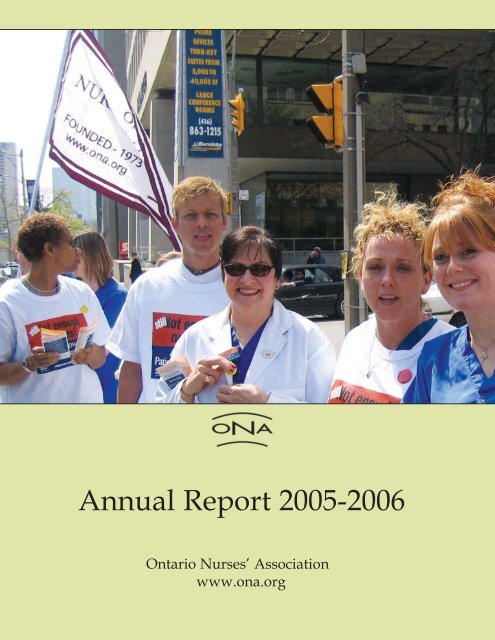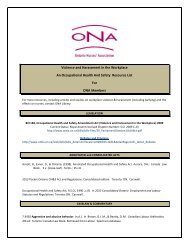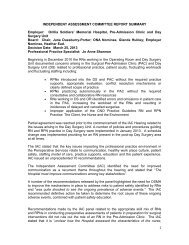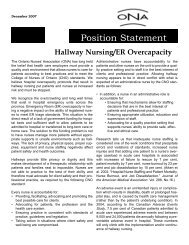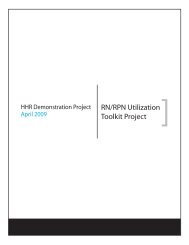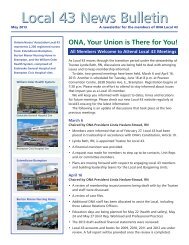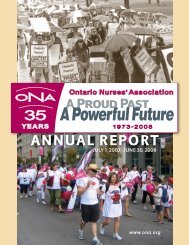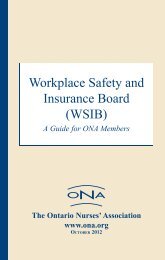Annual Report: July 1, 2005 - June 30, 2006 - Ontario Nurses ...
Annual Report: July 1, 2005 - June 30, 2006 - Ontario Nurses ...
Annual Report: July 1, 2005 - June 30, 2006 - Ontario Nurses ...
You also want an ePaper? Increase the reach of your titles
YUMPU automatically turns print PDFs into web optimized ePapers that Google loves.
<strong>Annual</strong> <strong>Report</strong> <strong>2005</strong>-<strong>2006</strong><strong>Ontario</strong> <strong>Nurses</strong>’ Associationwww.ona.org
Table of Contents<strong>2005</strong>-<strong>2006</strong> ONA Board..................................................3President’s Message............................................................4Vision Statement<strong>Ontario</strong> <strong>Nurses</strong>’ Association: Our Union.Respected. Strong. United.Committed to members who care for people.CEO’s Message.....................................................................5Bargaining ................................................................................6The Year in Review..............................................................7Organizing............................................................................. 11Political Campaigns............................................................12Education...............................................................................13Awards and Decisions..................................................14Staff Directory.....................................................................15Long-Service Employees..............................................16Financial <strong>Report</strong>................................................................17ONA Head Office, 85 Grenville St.,Ste. 400, Toronto ON M5S 3A2,tel: (416) 964-8833 toll-free: 1-800-387-5580, press 0fax: (416)964-8864 e-mail: onamail@ona.orgwww.ona.orgONA is the union representing 52,500 registered nurses and allied health professionals across <strong>Ontario</strong> workingin hospitals, long-term care facilities, public health, community health agencies and industry.© ONA <strong>2006</strong>2ONTARIO NURSES’ASSOCIATION
Bargaining: ONA at the Negotiating TableMembers undoubtedly regard the negotiationof collective agreements as ONA’s most importanttask – and the months prior to the publicationof this <strong>Annual</strong> <strong>Report</strong> were busy ones asstaff and members worked together to improvenurses’ wages, benefits and working conditions.HospitalsAfter a very long wait – some 18 months withouta contract – nurses received their mostrecent award through the binding arbitrationprocess in September <strong>2005</strong>. Wage gains includedhikes of 3 per cent and 3 per cent, effectivein April of 2004 and <strong>2005</strong>, plus 2 per cent as ofJanuary <strong>2006</strong> for nurses with 25 years experience.ONA members greeted the deal withrelief, but knew it wouldn’t solve the main problemsfacing the profession: how to attract andretain more nurses in <strong>Ontario</strong> by lesseningworkload and improving health and safety.Indeed, the arbitrator recognized as much, sayingthat problems of this sort had to beaddressed by government and employers –rather than by arbitration boards.The next time around (spring <strong>2006</strong>),ONA’s Hospital Central Negotiating Team washopeful – and reasonably confident – that anew contract could be fashioned at the tablewith the <strong>Ontario</strong> Hospital Association (OHA).Taking members’ opinions on bargainingpriorities carefully into account, the team wasdetermined to obtain a deal that wouldimprove working conditions as well as the compensationpackage. What the team didn’t counton was an employer association determined toseek substantial cuts to short- and long-termdisability benefits.As delegates to the <strong>June</strong> ProvincialCoordinators Meeting in Thunder Bay heard,the OHA sought to reduce sick pay from 100per cent to 70 per cent after a nurse’s twoweekabsence and then deny any payment forthe first two days of illness on a fourth and successiveabsence in any one year. Short–termdisability benefits for accommodated workerswould, according to the employers’ vision, onlybe restored after three weeks’ continual performanceof regular, full-time duties.With regard to long-term benefits, theOHA proposal was that these would begin atweek 27 and be paid at two-thirds’ insurableearnings, with no access to the grievance procedure.Apart from the employers’ association’sassumption that ONA would happily relinquishimportant gains, simply because hospitals areunder budgetary pressure, the most bizarreaspect of the process was the OHA’s publicrelations exercise. On May 29, after indicatingthat it had “no appetite” to proceed with talksbecause of ONA’s unwillingness to weaken<strong>Ontario</strong> Disability Income Plan (HOODIP) provisions,and despite encouraging talks on suchtopics as N95 respirators, Local HealthIntegration Networks and workload issues, theOHA tried to score points in the media by issuinga press release accusing ONA of walkingout on talks. OHA leaders were then upset byour appeals to nurses to tell the Premier, theMinister of Health and hospital leaders to getthe employers back to the table and drop themost regressive planks in their platform. Asthough a collective agreement weren’t the businessof the union’s membership!At press time, we are awaiting the arbitrationaward.Homes for the AgedSettlements in charitable and municipal homesbroadly reflected the hospital pattern.December <strong>2006</strong> will see mediation/arbitrationfor Eastern <strong>Ontario</strong> Homes for the Aged (thoseparticipating in the sub-sector’s only centralizedbargaining process).Nursing HomesClarification on the most recent homes awardwas issued on March 22, <strong>2006</strong>. The quest for anew contract for nurses working in those privately-owned,for-profit homes that participatein the central bargaining process (124 out of165) began as the period covered by thisreport came to a close. On <strong>June</strong> 9 the twosides exchanged bargaining proposals; directnegotiations were scheduled for Septemberand October, <strong>2006</strong>. Improvements in benefits,health and safety provisions and, as on prioroccasions, an attempt to achieve wage paritywith the hospital sector, will be the chief objectivesof the Nursing Homes CentralNegotiating Team. As of the time of writing wehave a tentative settlement.Community Care Access Centres(CCACs)The first half of <strong>2006</strong> saw the beginning of acomplex and challenging process to re-organize<strong>Ontario</strong>’s 42 CCACs into 14, in conformity with<strong>Ontario</strong>’s latest system for health care delivery,the Local Health Integration Networks. One ofONA’s priorities in <strong>2006</strong> was to negotiate collectiveagreements in those CCACs where contractswere ending prior to the amalgamationprocess. During the period covered by thisreport, five new contracts were obtained inCCACs. Efforts to obtain agreements proceededin others, including Halton (nurses andallied), Sarnia-Lambton and Muskoka East ParrySound, the latter a bargaining unit just certifiedon April 20, <strong>2006</strong>.Home CareOut of 27 bargaining units, 10 remain withoutmembers. Settlements were reached atVictorian Order of <strong>Nurses</strong> (VON) West ParrySound and St. Joseph’s Health Care. Bargainingproceeded at the VON Thunder Bay andDistrict, as well as the VON Peterborough-Victoria-Haliburton. Workers in this area willenjoy some additional stability as a result of thegovernment’s decision to extend successfulhome care bids from three to nine years, butcompetitive bidding will continue to applysevere downward pressure to wages andbenefits – where benefits exist.Public HealthOut of ONA’s 32 public health bargaining units,contracts were negotiated and ratified in threeduring the period covered by this document.They include the Algoma Health Unit, theRegional Municipality of York Health Unit andthe Grey Bruce Health Unit. The quest toobtain parity with hospital nurses remains a keyobjective in this sector. ONA regards 100 percent funding of public health by Queen’s Park asa key condition for addressing compensationdisparities among members employed in unitsacross the province.Industry and ClinicsONA has 19 bargaining units in this sub-sector.At press time, five were involved in differentstages of bargaining.6ONTARIO NURSES’ASSOCIATION
<strong>2005</strong>-<strong>2006</strong>Year in ReviewANNUAL REPORT <strong>2005</strong>-<strong>2006</strong>7
<strong>2005</strong>-<strong>2006</strong>: Year in Review<strong>July</strong> <strong>2005</strong>• Patient Felicity Scott dies <strong>July</strong> 15 at Forest Heights Long-term CareFacility in Kitchener, Local 15, after being assaulted by a 52 year-oldfellow resident. The tragedy highlights the need for people with violenttendencies and severe mental disabilities to be cared for in separatefacilities where staff and resources are adequate to addresstheir special needs, while ensuring a safe environment for others.• In North American labour news of interest to our Association, theService Employees International Union and the Teamsters announcethey are leaving the American Federation of Labor-Congress ofIndustrial Organizations on the eve of that body’s Chicago convention.The United Food and Commercial Workers and UNITE HERE,which represents garment and hotel workers, soon follow suit, settingup a rival U.S.-based labour central to be known as the Changeto Win coalition. These labour bodies, with the exception of theTeamsters, are associates of ONA in both the <strong>Ontario</strong> Federation ofLabour and the Canadian Labour Congress. There is no word of thesplit being replicated in this country.August <strong>2005</strong>• August 10 sees well over 1,000 health care workers and membersof the community rally in front of Sarnia’s city hall to protestannounced cuts by Bluewater Health, Local 19, liable to causeLambton County to lose 60,000 hours of nursing care – not includingthe depletion in services bound to result from the elimination ofother staff positions. According to Bluewater management, the facilityhas no choice but to lay off staff to reduce its $14 million deficit.Among the services scheduled to feel the axe is the hospital’s muchlovedpalliative care unit, a service that is the leading draw for donationsto the hospital’s foundation. At the rally, ONA Region 5 Vice-President Jeanne Soden criticizes Bluewater for its lack of transparency,saying that ONA Bargaining Unit President Pam Gallie can’t get acopy of a peer review report sent by the agency to the <strong>Ontario</strong> governmentthat probably formed the basis of the staff-cutting strategy.• <strong>Nurses</strong> are saddened – and angered – by news that a patient hasdied in an emergency room hallway while waiting for a bed at thePeterborough Regional Health Centre, Local 3. An ER nurse andONA member who prefers not to be identified tells Canadian Pressthat her colleagues are strapped due to staff shortages, while LocalCoordinator Louise Flaherty adds that patients frequently spendtime stationed in corridors. According to the hospital’s director ofcritical care, there were 18 patients in the hallways waiting for a bedon the day of the death; while that was a “bad” situation, it wasnot unusual.• Health Minister George Smitherman unveils a report on health carein northwestern <strong>Ontario</strong> launched as a result of Local 73, ThunderBay Regional Health Sciences Centre’s much-criticized policy of limitingaccess to beds to patients from the immediate area in periodswhen beds are scarce. The report authored by Tom Closson calls for,among other things, substantial investments in hospitals in SiouxLookout and Marathon, new services for cardiac patients in ThunderBay, as well as additional long-term care spaces.September <strong>2005</strong>• After a year-and-a-half working without a contract, ONA’s approximately45,000 hospital nurses finally receive a binding arbitrationaward that President Linda Haslam-Stroud calls “a basis to build onin the future…” but inadequate to meeting the chief challenges confrontingnurses, such as workload issues, health and safety problemsand the provincial nursing shortage. Haslam-Stroud says the deal willneither encourage many new nurses into the profession nor convinceexperienced professionals to remain longer on the job. Thecontract includes wage hikes of 3 per cent effective April 1, 2004, plusanother 3 per cent effective the following year. Additionally, there isan increase of 2 per cent more as of January 1, <strong>2006</strong> for nurses with25 years experience.• ONA launches the next phase of its Still Not Enough <strong>Nurses</strong> campaign,with advertisements covering bus shelters in towns and citiesaround the province.• Members of Local 83 at the Ottawa hospital hold a well-attendedStill Not Enough <strong>Nurses</strong> rally on September 14 that attracts coveragefrom most of the major media in the national capital area. AtUnion Station in Toronto, Region 3 ONA members distribute leafletsto commuters on their way to work – and receive an overwhelminglypositive response.October <strong>2005</strong>• ONA Local 4 reaches a settlement with the Grey Bruce HealthUnit’s Board of Health two days before members were set to strike,ratifying a three-year contract scheduled to expire in December2007. Wage gains of 3 per cent, 3 per cent and 4 per cent are made.• As the month begins, reports appear in the media detailing thedeaths of four residents in Toronto’s Seven Oaks Home for the Agedas a result of what is initially described as “an unknown flu-like illness.”SARS and Avian Flu are ruled out but the city remains nervous. Thedeath toll climbs. On October 7, the city announces thatLegionnaires’ disease is the culprit.• The <strong>Ontario</strong> Federation of Labour (OFL) holds a press conferencein Kingston to release its report entitled Understaffed and UnderPressure, on the perilous state of the province’s health care system.The OFL argues that as a result of close consultation with health careworkers in 17 centres throughout <strong>Ontario</strong>, staff are exhausted andexcessively stressed out as they try and care for our sick and injured.• ONA releases its main Still Not Enough <strong>Nurses</strong> background document,Patients Matter: The Roots of a Health Care Problem andHow to Alleviate it.8ONTARIO NURSES’ASSOCIATION
<strong>2005</strong>-<strong>2006</strong>: Year in ReviewNovember <strong>2005</strong>• On November 9-10, ONA holds a Provincial Coordinators Meetingat the Royal York Hotel in Toronto. Guest speakers Linda O’Brien-Pallas, an expert on <strong>Ontario</strong>’s nursing demographic, and journalistMichael Enright help make the event an informative one. Enright tellsnurses to “hold the government’s feet to the fire” with the Still NotEnough <strong>Nurses</strong> campaign.• ONA’s delegation makes a splash at the union’s first-ever <strong>Ontario</strong>Federation of Labour (OFL) convention, from November 21-25 inToronto. OFL President Wayne Samuelson makes health care – anddefence of a publicly administered system – front and centre in theconvention’s policy discussions.• At the OFL convention, conversations between ONA PresidentLinda Haslam-Stroud and other union leaders spark the birth of afour-union coalition, involving the Canadian Union of PublicEmployees, the <strong>Ontario</strong> Public Service Employees Union and theService Employees International Union (Local 1 <strong>Ontario</strong>) determinedto ensure that the <strong>Ontario</strong> government’s Local HealthIntegration Networks (LHINs) initiative doesn’t lead to more privatization,the loss of union jobs and the deterioration of health carefor Ontarians.• Ontarians are shocked and saddened by the murder of Local 8member Lori Dupont on November 12 at Hôtel Dieu GraceHospital in Windsor at the hands of anesthesiologist Marc Daniel. OnNovember 28, a series of demonstrations and vigils take place asONA and other organizations mourn the tragic loss of a friend andcolleague and demand improved measures from the governmentand employers to protect women from violence and harassment –on the job and off.• ONA renews its censure of Bluewater Health, Local 19, in Sarnia.December <strong>2005</strong>• Staff and political leaders from <strong>Ontario</strong>’s four major health careunions (the Four Union Coalition) meet in downtown Toronto toplot a response to the government’s Local Health IntegrationNetworks (LHINs) legislation. Participants suggest collaboration on arange of issues, including organizing non-unionized workplaces, bargaining,pension matters and a communications plan to publicizetheir criticisms of the LHIN initiative. Later in the month, ONA holdsa special meeting of regional leaders to discuss the campaign and itsobjective of seriously amending Bill 36 to block further privatization,ensure the protection of local health services and defend union jobs.Delegates also hear that ONA and its allies feel the government’s 14LHIN boards should be elected, rather than appointed, if Queen’sPark is serious about making health care more responsive tocommunities.• Local 13 Bargaining Unit President Ann Kennealy criticizes the governmentfor choosing to privately finance the capital constructionproject at Sudbury Regional Hospital. “Alternative financing and procurementis just another expression for privatization,” she says.January <strong>2006</strong>• The LHINs campaign unfolds, with ONA joining the other threeunions in 17 regional mobilization meetings across the province. Atthe meetings, health care workers hear an analysis of the governmentinitiative, ask questions, state their views and plan joint actions. VickiMcKenna (newly elected First Vice President) takes the lead forONA.• ONA takes the lead in organizing the meetings in Windsor andOttawa, with attendance ranging from approximately 100 concernedworkers in <strong>Ontario</strong>’s auto city to about five times that many in thenational capital.• The Conservative Party under Steven Harper wins the federal electionand appoints former <strong>Ontario</strong> Tory Cabinet Minister TonyClement, a keen advocate of private sector involvement in healthcare, as Minister of Health. Canadian Federation of <strong>Nurses</strong> UnionsPresident Linda Silas comments that nurses “do not believe the solutionto [long wait times and other systemic woes] is a privately deliveredsystem.” Silas argues that governments have to address the“determinants” of poor health by tackling poverty and providingmore affordable housing.• The Superior Court of Justice adjourns ONA’s SARS lawsuit inwhich we maintain the provincial government is legally responsiblefor injury and illness sustained by members during the 2003 Torontohealth crisis. The judge was concerned about deciding this case whenthere are two other cases, which she viewed as potentially similar,pending before the court of appeal.February <strong>2006</strong>• Local 35 Bargaining Unit President Greg Walden responds forcefullyto an announcement by Chatham-Kent’s department of social servicesto eliminate seven registered nursing positions at RiverviewGardens Home for the Aged. In a letter to the Chatham Daily News,Walden expresses doubt that the six full-time and three part-timeRNs remaining in the facility will be able to guarantee top-qualitycare to the centre’s 320 residents.• Valentine’s Day <strong>2006</strong> is a day for activists: workplace protests againstthe <strong>Ontario</strong> government’s LHIN legislation take place all over theprovince as members of the four health unions call on Ontarians to“Protect the Heart of Health Care.”• ONA issues an invitation to female members from designatedgroups (aboriginal, visible minorities, lesbian/gay/bisexual/transgendered,disabled and francophone) to participate in a LeadershipDevelopment Program scheduled for the fall of <strong>2006</strong>. The programis to be an intensive, five-day session designed to help cultivate newleaders who reflect our diverse grassroots.ANNUAL REPORT <strong>2005</strong>-<strong>2006</strong>9
Political Campaigns:Spreading our MessageONA understands that issues ofhealth care and funding for hospitals,long-term care, community care andpublic health facilities are far frombeing a matter of concern only toworkers, government and employers.Obviously, the <strong>Ontario</strong> public has ahuge stake in the state of its healthcare.When health care facilities areunderstaffed, nurses suffer – but theimpact on patients is also easy toimagine. Or perhaps we should say,“easy to experience,” since Ontarianshave by now a fairly tangible sense ofwhat it is like to seek care in a system lacking an adequate number ofhealth professionals.So in <strong>2005</strong>-<strong>2006</strong>, ONA took its chief concerns to the streets and tothe media for two main reasons: because health care is everyone’s affairand because nurses are more likely to win their arguments and improvetheir working lives if the public is mobilized and on their side.Still Not Enough <strong>Nurses</strong> CampaignThe Still Not Enough <strong>Nurses</strong> (SNEN) campaign heated up in this period,with our message moving from the province’s bus shelters, billboards andpicket signs (wielded by protesting, information-dealing members) to thetelevision screens. The bright orange and blue of our placards, a potentset of arguments that few were inclined to dispute, and massive interestfrom the province’s media community, ensured that well over half ofOntarians heard our message loud and clear.Meanwhile, the campaign website, www.stillnotenoughnurses.ca,received an impressive number of hits from members of the public interestedin informing themselves about the nursing shortage and the union’sefforts to combat it. The site featured, and continues to feature, a quiz, anabbreviated version of ONA’s Patients Matter. The Roots of a HealthCare Problem and How to Alleviate it (released in its longer, print versionin October <strong>2005</strong>) and a Share Your Stories section.ONA members were busy when it came time to taking the campaigndirectly to the public. Some of the most successful actions included a mid-September <strong>2005</strong> rally by nurses at the Ottawa hospital, spearheaded byLocal 83’s Eric Drouin, a member who knew the importance of contactingevery media outlet in the Capital Region prior to a rally. On May Dayin Toronto, an impressive contingent led by President Linda Haslam-Stroud marched along University Avenue, through the hospital corridor,before delivering more than 8,000 signed Still Not Enough <strong>Nurses</strong> cardsto Queen’s Park. Health Minister George Smitherman, who spent muchof <strong>2005</strong>-<strong>2006</strong> disputing the labour movement’s claims about the direstate of health care staffing, was on hand to receive the cards. NDPHealth Critic Shelley Martel delivered them to him in the Legislature.Other actions included early morning handouts of the campaignbrochure at, for example, busy train stations. In general, ONA memberssought out direct contact with Ontarians to discuss the state of affairs inour health care facilities. All our hard work appears to have paid off. Anindependent advertisement effectivenessstudy was conducted and determinedthat the ads were a success.Local Health IntegrationNetworks CampaignStarting in December <strong>2005</strong> anothercampaign came to dominate the timeand efforts of ONA members andstaff. ONA joined forces with ourfriends at the Canadian Union ofPublic Employees, the <strong>Ontario</strong> PublicService Employees Union and theService Employees InternationalUnion (Local 1 <strong>Ontario</strong>) to opposeaspects of the government’s Local Health Integration Network(LHIN) plan.We felt that if the government was really trying to increase localaccountability in the delivery of health care by setting up 14 regionalboards, these boards would be elected rather than appointed by Queen’sPark. We were alarmed by their mandates to “economize” by promotingmergers between health care providers, fearing that such moves coulddeprive smaller communities of some health services while underminingthe rights and working conditions of unionized workers. Provisions allowingthe provincial government to privatize “non-clinical” services in hospitalsseemed an assault on the rights of cleaners and cafeteria workers –and an affront to patients, sentenced to receive services from firms drivenby the bottom line.So ONA and its allies moved into action. Over the course of severalweeks in January <strong>2006</strong>, we held regional meetings in 16 cities acrossthe province. On Valentine’s Day, we held protests outside workplaces innumerous <strong>Ontario</strong> communities. We also joined the <strong>Ontario</strong> HealthCoalition in rallies against the government’s version of local healthcare delivery.Some commitment from the <strong>Ontario</strong> government to reinforce public,not-for-profit delivery was won. ONA also began working to put<strong>Ontario</strong>’s Public Sector Labour Relations Transition Act to good use bytrying to ensure, when mergers and demergers of health care employersdo occur, union rights are protected. But issues on the LHINs front werefar from settled by press time.What’s Next?The defence of publicly delivered, not-for-profit health care – that is, thequest to make Medicare better – must continue. ONA also has to presson with its quest to protect nurses’ lives on the job. We will continue totell government that, for example, all front-line caregivers require N95respirators in the event of a pandemic. And we won’t hesitate to involveour allies – including the <strong>Ontario</strong> public – in making that demand.And of course the nursing shortage continues. Still Not Enough<strong>Nurses</strong> is a cry ONA will repeat until it no longer describes the reality of<strong>Ontario</strong>’s health care facilities.12ONTARIO NURSES’ASSOCIATION
Awards and Decisions:mAdvancing ONA’s CauseThe following are some notable ONA victories from the period in review from the realmof rights and interest arbitration, Workplace Safety and Insurance Board (WSIB), and<strong>Ontario</strong> Labour Relations Board (OLRB) verdicts.Awards and DecisionsAwards and DecisionsAwards and DecisionsAwards and DecisionsAwards and DecisionsAwards and DecisionsAwards and Decisions• On November 17, <strong>2005</strong>, a key rights arbitration award came downthat should serve to enhance ONA’s argument against the growingpractice of replacing registered nurses with less skilled workers.In a decision that went against the Scarborough Hospital, thearbitrator applied Article 10.12 (a) of the collective agreement todetermine that in one unit in the facility in particular (where acuityis high and patients unpredictable), a decision to substitute RNswith registered practical nurses would not maintain “quality patientcare.” The employer presented a study at the hearing in supportof its claim that the proposed “skill mix changes” were appropriate,but the research contained therein was of a general nature anddidn’t take into account the specific needs of those seeking care inthe unit where the RN layoffs were to occur. This was the firstsignificant decision regarding the meaning of Article 10.12 (a).• A nurse became emotionally ill after witnessing the ravages ofSARS. WSIB denied her entitlement and benefits because entitlementto mental stress, when it arises as a result of the normalworking environment, is not allowed – and nurses deal withinfectious disease on a regular basis. But ONA demonstrated thatthe worker was entitled to benefits because in this case stressresulted from a sudden and unexpected traumatic event. TheBoard’s appeal resolution officer agreed that the nurse sufferedpost-traumatic stress subsequent to April 3, 2003, and she receivedWSIB entitlement for all lost time and health care benefits. In short,health care professionals cannot be expected to cheerfully andhealthfully bear any crisis that might occur at their place of work.Awards and Decisions• In a groundbreaking preliminary decision, released in October<strong>2005</strong>, the arbitrator concluded that the Eastern <strong>Ontario</strong> HealthUnit qualifies as an arm of government and hence is subject to theCharter of Rights and Freedoms. The case involved a grievanceAwards and Decisionsagainst the employer’s policy of staff immunization againstinfluenza. The arbitration is proceeding to a consideration ofwhether the policy violates Section 7 of the Charter (Security ofthe Person) and if yes, whether this violation is reasonable in a freeand democratic society.• In a January 9 decision, the arbitrator determined that Articles 9.01and 11.09 of the hospital collective agreement generally recognizethe right to career development, and don’t just authorize courseattendance for nurses when the skills they plan to acquire are usefulto their current employer. In this case, St. Joseph’s Elliot Lakedenied unpaid leave to an employee on the grounds that the latter’sselected program did not involve skills to be used at St.Joseph’s (the nurse also worked part-time for Sudbury RegionalHospital, which was paying him to attend). The grievor was able toattend the course, with the assistance of his manager and bysacrificing vacation time and arranging to have his shifts covered bycasuals. ONA sought the return of that vacation time.• In a <strong>June</strong> 6, <strong>2006</strong>, decision, the arbitrator decided that in the caseof an ONA bargaining unit participating in central hospital negotiations(Four Counties Health Services), registered practical nurseswith 25 years experience forming part of the bargaining unit arealso entitled to the extra salary grid and the two per cent additionalcompensation awarded in September <strong>2005</strong>. The arbitrator saidthat the Keller-chaired interest Board applied the retention andrecruitment incentive to “employees,” intending both categories ofAwards and DecisionsAwards and DecisionsAwards and DecisionsAwards and DecisionsAwards and Decisionsnurses to be taken into account. When the Keller Board wanted todistinguish between the two classes, it employed the terms RN andRPN, noted the arbitrator. A detailed article on this decision waspublished in ONA Vision magazine.Awards and DecisionsAwards and DecisionsAwards and DecisionsAwards and DecisionsAwards and DecisionsAwards and Decisions14ONTARIO NURSES’ASSOCIATION
ONA: Staff DirectoryEmployee Services TeamParke,Marywynne, ManagerDennis, MaryPerry, CarmelLEAP TeamBoudreau, JoanCiavaglia, RuthSchmidt, ChristineThibault, ThomasWickham, AndreaOrganizational LearningFantham, Judith, ManagerIngrey, Carmen, Library ClerkRobert, Michelle, LRAWhite, Victoria, Library TechnicianProvincial OrganizationalServices TeamThomson, Gayle, ManagerAnning, SusanBorrelli, MariaBrereton, MarkethaBright, AndreaBurns, BrookeDeveaux, LisaEramo, GloriaFalls, GisellaFragis, HelenGherman, NickHamid, BibiHurter, Hedy-AnneJugo, RuthKothary, SunilLosier, DidierMa, HelenMatvichuk, MariaNicol, SusanPatel, MinaxiStapleton, JaneUscimiuk, PeterVeinott, RobVelauthapillai, SureshProvincial Services TeamAnderson, Doug, ManagerDavidson, Janiss, Manager,LHINs Coordination, Retention andRecruitment Team and WSIB PilotProjectBoileau, Raymonde, LROBrown, Sheila, LRABujna, Erna, LROCooke, Leanne, Administrative AssistantGosselin, Linda, LROHaynes, Rozanna, LROKing, Mary Lou, LROLokre, Anu, LROMarkovic, Mariana, LRONicholson, David, LROSandercock, Karen, LROSchachter, Shalom, HLDAA/Long-TermCare Regulation LeadPublic Relations TeamBirt, Peter D., ManagerBond, Sheree, LROFeatherstone, Ruth, LROJoseph, Paula, LRALevenson, Melanie, LRORheault, Karen, LROWalter, Lawrence, LROStrategy TeamHaslam-Stroud, Linda, PresidentMcKenna, Vicki, First Vice-PresidentBell, Lesley, CEOAnderson, Dan, DirectorAndrews, Noelle, DirectorBarruch, SusanBullock, LindaEllison, Mary JaneLynn, Gloria, DirectorMcCourt, LiseReeves, AngelaTechnology Services TeamLaxdal, David, ManagerCesario, GianfrancoChen, LaurenceHall, RandyHuntley, RobertLou, Yu (Charley)Shaw, LilySprague, JefferyTolton, CeliaYim, AlfredDISTRICT SERVICE TEAMSEast District Service TeamPelletier, Marc-Andre, ManagerAumand, Meg, LRABoissonnault, Claude, LROBossé, Ginette, LRACohen, Caroline, LRODaxon, Julie, LRADewar, Elizabeth, LROFord, Louise, LRAFraser, James, LROGibson, Pat, LROGifford, Gary, LROHenson, Anita, LROHunter, Linda, LROMacKay, Ralph, LROMcCulloch, Sue, LROMcDonell, Heather, LROPaine, Larry, LROPrégent, Jean-Francois, LROPucsek-Berman, Violet, LRARenaud, Daniel, LROSadoway, Tricia, LROShogren, Tina, LRANorth District Service TeamMitchell, Enid, ManagerBarrette, Cyndee, LRABurns, Judith, LROCaissey, Ina, LROCaldwell, Patricia, LROCaporicci, Angele, LROCarr, Patricia, LROChevrier, Sharri-Ann, LRACiccone, Patricia, LRACritchley-Pineo, Jennie, LROD’Orsay, John, LROEgo, Diane, LRAGillan, Rosemary, LROHenley, Joshua, LROJohnson, Nancy, LROKutchaw, Diana, LROLund, Joanne, LRAMartin, Michele, LROMcColl, Michelle, LROMills, Ralph, LROOram, Glen, LROPrepp, Carolyn, LRORobert, Kelly, LRARupert, Rob, LROTataryn, Jamie, LRASouth District Service TeamMacDonald,Valerie, ManagerAllan-Russell, Joan, LRAAlleyne, Lesline, LROBellot, Noeline, LROBem, Carmen, LRABrown, Athena, LROCalvin, Marjorie, LRACodjoe, Esi, LROGagliano, Anna, LRAGagliano, Ester, LRAGreer, Mary, LROHarper, Lorraine, LROLefebvre-Hinton, Pauline, LROLobsinger, Steven, LROMarshall, Paul, LROMcIlwaine, Judith, LROMednick, Beverly, LROMiller, Mark, LROMorra, Lynn, LRAPapernick, Stacey, LROPilgrim, Claudine, LRORead, Linda, LRARobinson, Sharon, LRARuddock, Sophia, LROStout, Matthew, LROStoveld, Janice, LROStreet, Sheri, LROSzuty, Tom, LROTodkill, Karen, LROWall, Elizabeth, LRAWest District Service TeamMathers, Beverly, ManagerAlexander, Donna, LROAllen, Mary, LROAllingham, Jill, LRABarlow, Linda, LRABishop, Keri-Lynn, LRABrosseau, Michelle, LROBrown, Karen, LROButt, Nicole, LROCaille, Dawn, LRAConlon, Barbara, LRODobrucki, Rob, LRODucie, Margaret, LROFinch, Judy, LRAForster, Cindy, LROHicks, Donna, LROIles-Peck, Catherine, LROIonson, Colleen, LROJohnston, Colin, LROKotevich, Victoria, LRALittle, Helle, LROMallett, Dora, LROMazurk, Marsha, LROMedwid, Zirka, LROPalmer, Marsha, LROPeckham, Diane, LRASarides, Phil, LROShannon, Jo Anne, LROSnell, Kathi, LROTursa, Brenda, LRAVance, John, LROANNUAL REPORT <strong>2005</strong>-<strong>2006</strong>15
ONA Long-Service Employees5 YearsNoeline Bellot, South District Service TeamMary Dennis, Employee Services TeamJudy Finch, West District Service TeamNick Gherman, Provincial Organizational Services TeamRozanna Haynes, Provincial Services TeamRuth Jugo, Provincial Organizational Services TeamHeather McDonell, East District Service TeamSusan Nicol, Provincial Organizational Services TeamCelia Tolton, Technology Services Team10 YearsErna Bujna, Provincial Services TeamDiane Ego, North District Service TeamVictoria Kotevich, West District Service TeamKelly Ann Robert, North District Service TeamMarywynne Parke, Manager, Employee Services TeamLinda Hunter, East District Service TeamCatherine Illes-Peck, West District Service TeamMelanie Levenson, Public Relations TeamJoanne Lund, North District Service TeamMarsha Mazurk, West District Service TeamCarolyn Prepp, North District Service TeamViolet Pucsek-Berman, East District Service TeamMargaret Ducie, West District Service TeamShalom Schachter, Provincial Services TeamElizabeth Wall, South District Service TeamMarjorie Calvin, South District Service TeamJaniss Davidson, Manager, Provincial Services Team20 Years25 Years<strong>30</strong> Years15 YearsLesley Bell, Chief Executive OfficerSheila Brown, Provincial Services TeamGloria Eramo, Provincial Organizational Services TeamPat Gibson, East District Service TeamPauline Lefebvre-Hinton, South District Service TeamDidier Losier, Provincial Organizational Service TeamLily Shaw, Technology Services TeamDan Anderson, Director, Strategy Team35 Years16ONTARIO NURSES’ASSOCIATION
ONA Consolidated Financial Statements for Year ended December 31, <strong>2005</strong>Consolidated Balance SheetDecember 31 <strong>2005</strong> 2004AssetsCurrentCash & short-term investments (at cost) $ 3,142,752 $ 5,059,263Access Health/VON investment – In Trust 135,472 129,810Dues & other receivables 4,020,128 3,909,166Prepaids 449,647 669,3<strong>30</strong>7,747,999 9,767,569Capital assets (at net book value) 5,441,798 5,206,472Marketable investments (at cost) 9,617,454 8,937,100Investment in ONA Liability Insurance Ltd. (equity method) 5,853,073 5,742,055$ 28,660,324 $ 29,653,196Liabilities and Net AssetsCurrentAccounts payable & accrued liabilities $ 5,945,360 $ 5,459,394Access Health/VON payable 135,472 129,810Accrued LEAP claims 1,267,<strong>30</strong>0 1,184,700Current portion of capital lease obligation 517,443 568,611Capital lease obligation7,865,575616,7527,342,515326,858Accrued benefit liability 850,<strong>30</strong>0 681,2009,332,627 8,350,573Net AssetsInvested in capital assets 4,<strong>30</strong>7,603 4,311,003Invested in ONA Liability Insurance Ltd. 5,853,073 5,742,055Internally restricted 6,<strong>30</strong>3,782 7,011,509Unrestricted 2,863,239 4,238,05619,327,697 21,<strong>30</strong>2,623$ 28,660,324 $ 29,653,196The above financial information is a condensed version of ONA’s audited financial statements for theyears ended December 31, 2004, and December 31, <strong>2005</strong>. The complete financial statements, includingthe Auditor's <strong>Report</strong> and accompanying notes have been provided to your Local leadership and areavailable upon request.ANNUAL REPORT <strong>2005</strong>-<strong>2006</strong>17
ONA Consolidated Financial Statements for Year ended December 31, <strong>2005</strong>Consolidated Statement of OperationsFor the year ended December 31 <strong>2005</strong> 2004RevenueMembership dues $ 32,751,077 $ 32,248,592Investment income 837,686 776,562Other 549,193 467,69934,137,956 33,492,853ExpenseGovernance / External vision 1,954,953 1,629,634Membership services 1,033,285 1,326,082Service teams 12,838,311 11,719,796Support teams 8,785,786 7,804,175Fixed expenses 4,544,580 3,992,879Building operations 743,<strong>30</strong>6 708,403Local funding 651,589 -Program costs (Security/LEAP/AIDS/LTD/Supplementary) 4,616,251 4,097,84135,168,061 31,278,810(Deficiency)/excess of revenue over expensebefore amortization (1,0<strong>30</strong>,105) 2,214,043Amortization (944,821) (890,285)(Deficiency)/excess of revenue over expense $ (1,974,926) $ 1,323,758The above financial information is a condensed version of ONA’s audited financial statements for the yearsended December 31, 2004, and December 31, <strong>2005</strong>. The complete financial statements, including the Auditor's<strong>Report</strong> and accompanying notes have been provided to your Local leadership and are available upon request.18ONTARIO NURSES’ASSOCIATION
20THE ONTARIO NURSES’ ASSOCIATION85 Grenville Street, Suite 400, Toronto, <strong>Ontario</strong> M5S 3A21-800-387-5580 • In Toronto: (416) 964-8833 • Fax: (416) 964-8864E-mail: onamail@ona.org • Visit our website at: www.ona.orgONTARIO NURSES’ASSOCIA-


